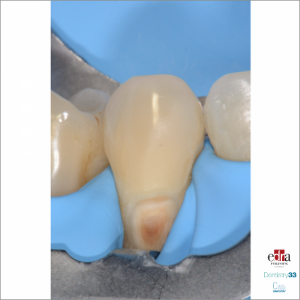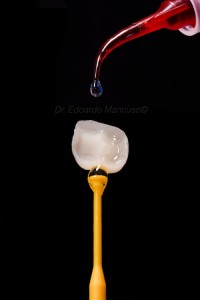
How does the universal adhesive’s film thickness affect its ability to effectively bond to dentin?
Lorenzo Breschi, Diego D’Urso
Introduction: Modern composite restorations rely on increasingly efficient adhesive systems, but sometimes it is not clear how thick the adhesive layer needs to be. The group of professor Van Meerbeek investigated the influence of adhesive resin application modalities on the film thickness and subsequent bonding performance. More precisely, the effectiveness of a two-step universal adhesive (UA) bonded in self-etch (SE) bonding mode to high C-factor class-I cavity-bottom dentin was investigated
Materials and methods: Eighty human third molars were collected, and randomly allocated to eight groups (n = 10), with four subgroups following two aging periods (“immediate” versus “aged”). After the application of the primer G2-Bond Universal (G2B, GC), the adhesive resin was applied into standard class-I cavities following four application modalities: (1) one layer, strongly air-blown; (2) one layer, gently air-blown; (3) two layers, each gently air-blown; (4) one layer, not air-blown. After the composite restorations, upon 1-week storage, all specimens were sectioned using a semi-automated diamond saw to obtain one central rectangular micro-specimen per tooth/cavity. Only the central μ-specimen was tested to standardize the adhesive film thickness and parallelism with the dentin substrate as good as possible, hereby avoiding any potential thickening effects near the cavity corners. The adhesive resin film thickness was measured using optical microscopy. The micro-tensile bond strength (μTBS) was tested immediately and upon 100,000 thermocycles.
Results: G2B’s μTBS was significantly affected by the adhesive resin application modality and aging. Gently air-blowing the adhesive resin resulted in significantly higher immediate μTBS than strong air-blowing or no air-blowing. No significant difference in μTBS was found between single or double gently air-blown adhesive resin applications. The adhesive resin film thickness significantly varied with the application modalities.
Conclusion: The adhesive resin layer thickness influenced the bonding efficiency of the two-step UA to high C-factor class-I cavity-bottom dentin. According to Tang’s study, a film thickness ranging between 36 and 90 μm appeared to favorably influence bonding effectiveness. A too thin or too thick adhesive layer interfered with the dental adhesive’s bonding function.
Improper air-blowing of the adhesive resin resulted in decreased bonding effectiveness in the two-step UA process, highlighting the importance for dental practitioners to meticulously adhere to the manufacturer's guidelines.
Keywords: Thickness, Universal Adhesives, Application modalities, Air-blown, Bond strength test
For more information: Does the universal adhesive’s film thickness affect dentin‐bonding effectiveness? C. Tang, B. Mercelis, K. Yoshihara, M. Peumans, B. Van Meerbeek. Clinical Oral Investigations (2024) 28:150
Source: https://doi.org/10.1007/s00784-024-05523-7
 Related articles
Related articles
Restorative dentistry 22 September 2021
What’s the best adhesive protocol for non carious cervical lesions?
Co-authors: A. Comba, F. Florenzano
So far there is no consensus about the best universal adhesive system mode to use for restoring cervical lesion . For that reason, Dr. Josic and his research group conducted a systematic review...
Restorative dentistry 01 April 2021
STATE OF THE ART OF UNIVERSAL ADHESISIVES; CLINICAL PERFORMANCE: A systematic review of literature
Authors: Stefano Daniele, Andrea Alessandri
The aim of this systematic review it’s to provide a critical evaluation about Universal adhesives to the currently adhesive’s procedures considered as gold standard in dental adhesion strategy...
“Progress means simplifying” not complicating. Manufacturers have well understood this concept and have tried over the years to simplify adhesion clinical...
Ormco Corporation, a global leader in orthodontic solutions for over 60 years, is thrilled to announce the modernization of the commonplace adhesive and bonding process with the introduction of Ormco...
Orthobond Corporation, a leader in covalently-bound antibacterial surface technologies with broad applications in the medical device industry, recently announced the successful in-house production...
 Read more
Read more
Much like EMTs rushing to the scene after an accident, stem cells hurry to the site of a skull fracture to start mending the damage. A new finding has uncovered the signaling mechanism that triggers...
Products 05 November 2025
SimplyTest has launched a groundbreaking saliva-based test to detect high-risk strains of oral human papillomavirus (HPV), a major cause of oropharyngeal cancers.
News 05 November 2025
Perimetrics, Inc., a dental technology company pioneering quantitative diagnostics, announced today that the U.S. Food and Drug Administration (FDA) has granted clearance for the InnerView...
News 05 November 2025
On October 15, open enrollment for Medicare began nationwide. Hundreds of thousands of seniors in New Jersey will once again face the challenge of finding the right Medicare coverage, including the...
Digital Dentistry 04 November 2025
Digitalisation is an expanding field in dentistry and implementation of digital teaching methods in dental education is an essential part of modern education.














